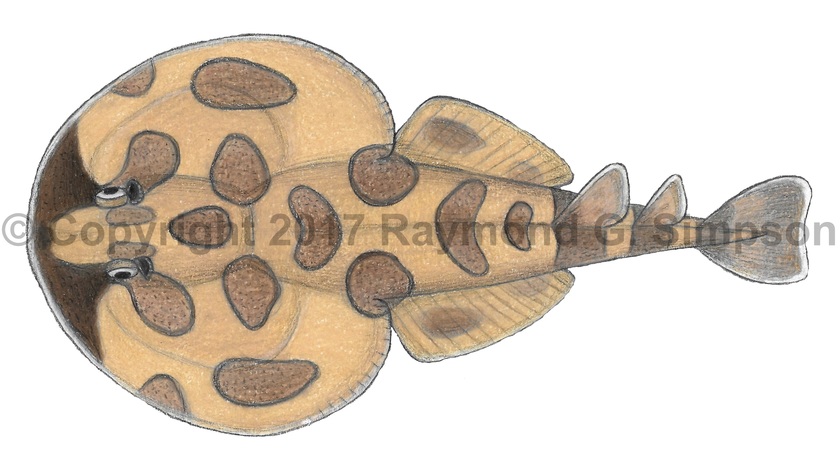
Common Name
Lesser Electric Ray
Year Described
Griffith & Smith, 1834
Identification
Disk large, fairly thickened, and oval-shaped with kidney-shaped electric organs under each pectoral fin base. Body quite flat along entire width. Mouth relatively small with well developed labial cartilage. Teeth small but sharp (~26 rows) and not visible when mouth is closed. Eyes large and projecting. Spiracles large with short papillae (less in small fish). Nostrils fused with broad nasal curtain. Pectoral fins short. Tail a little shorter than disk with low fleshy ridges. Dorsal fins about equal in size and rounded. Second dorsal a little taller. Inter-dorsal space much shorter than length of dorsal base. Pelvic fins broad and long, without projecting anterior lobes. Pelvic fins not joined. Claspers very short and stout. Caudal fin broad with a rounded to truncate posterior margin. Claspers longer and project beyond pelvic fin in males. Skin entirely smooth.
Color
Dorsal color pattern highly variable. Small specimens with a bold, contrasting pattern of large brown blotches surrounded by small dark brown spots, semicircles, or solid rings. The blotches are much larger than eye. Larger specimens with a diffuse blotched pattern dorsally with dark brown markings radiating from the eye onto the snout and cheek. Darker areas often with dense black speckles. Some individuals lack snout markings or heavy brown speckling. The largest individuals have a faint pattern overall. Ventrum whitish, with or without variable brown blotching.
Size
Maximum size to 65cm TL.
Habitat
Inhabits fairly shallow water (up to 35m) on soft bottoms, seagrass beds, and around coral reefs.
Range
Widespread from North Carolina to the coast of Colombia and Venezuela on continental coastlines and around the Caribbean islands.
References
Compagno, L.J.V. 2002. Sharks. In: Carpenter, K.E. (Editor) FAO Identification Guide for Fishery Purposes. The Living Marine Resources of The Western Central Atlantic. Volume 1: Introduction, mollusks, crustaceans, hagfishes, sharks, batoid fishes, and chimaeras. ASIH Special Publication No. 5. FAO, Rome.
Last, P.R., White, W.T., Carvalho, M.R. de, Séret, B., Stehmann, M.F.W & Naylor, G.J.P (Eds.). 2016. Rays of the World. CSIRO Publishing, Melbourne.
Other Notes
All records of Narcine brasiliensis from north of Brazil refer to N. bancroftii. The southern limit of N. bancroftii is unclear as the status of Narcine sp. (Smallspotted Numbfish) from northern South America has not been determined. Appears to be fully allopatric from the Brazilian species, N. brasiliensis.